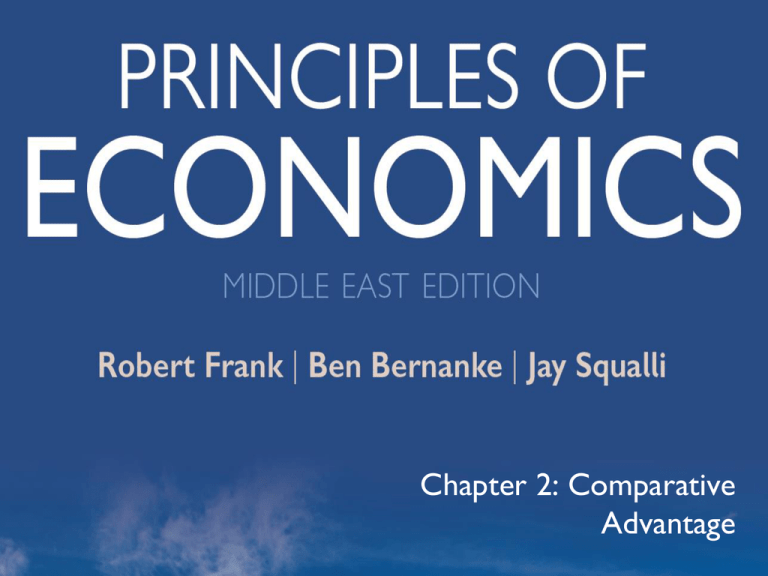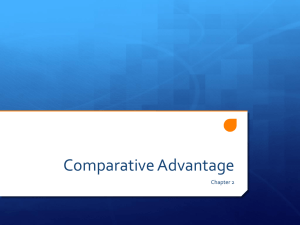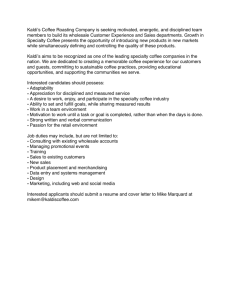
Chapter 2: Comparative
Advantage
©2012 The McGraw-Hill Companies, All Rights Reserved
1
Learning Objectives: Understand
1. The Principle of Comparative Advantage
2. The Principle of Increasing Opportunity Cost
(also called the Low-Hanging-Fruit Principle)
3. Factors that shift the menu of production
possibilities
4. The role of comparative advantage in
international trade
©2012 The McGraw-Hill Companies, All Rights Reserved
2
Do It Yourself?
Joe Jamail, a highly successful Lebanese-American
trial attorney, employs another attorney to write
his will
Writing
your own will
Opportunity cost of 2 hours
Hiring someone to spend 4 hours
on your will
Making the right economic choice
2 hours
$10,000+
$3,200
Priceless
Do It Yourself only when
Opportunity cost < hired cost
©2012 The McGraw-Hill Companies, All Rights Reserved
3
Production Advantages: Previous Example
From the previous example:
Jamail
has an absolute advantage at preparing
his will
Because he can perform that task than another
lawyer
Other
lawyer has a comparative advantage
at preparing the will
Because his opportunity cost of performing that task
is lower than Jamail’s
©2012 The McGraw-Hill Companies, All Rights Reserved
4
Production Advantages
Definitions
Absolute
advantage
Lowest production cost
one person has an absolute advantage over another if he or
she takes fewer hours to perform a task than the other
person
Comparative
advantage
Lower opportunity cost than someone else
one person has a comparative advantage over another if his
or her opportunity cost of performing a task is lower than
the other person’s opportunity cost
©2012 The McGraw-Hill Companies, All Rights Reserved
5
The Principle of Comparative Advantage
The Principle of Comparative Advantage
Everyone does best when each concentrates
on the activity with the lowest opportunity cost
Opens doors for specialization have you ever met
an engineer who is also a medical doctor? Or a
mechanic who is also a professor? defines the basis
for trade among people and countries
©2012 The McGraw-Hill Companies, All Rights Reserved
6
Comparative Advantage Example
Production Times
Web Update
Bike Repair
Ayden
20 minutes
10 minutes
Ghadah
30 minutes
30 minutes
Ayden and Ghadah can each update web pages
and repair bikes but Ayden has an absolute
advantage in both
Because it takes Ayden less time to perform each task
• In an 8 hour day, we can translate this into quantities
Production Output
Web Update
Bike Repair
Ayden
24
48
Ghadah
16
16
©2012 The McGraw-Hill Companies, All Rights Reserved
7
Comparative Advantage Example
Production Output
Web Update
Bike Repair
Ayden
24
48
Ghadah
16
16
Opportunity Cost
Ayden
Ghadah
Web Update
2 repairs
1 repair
©2012 The McGraw-Hill Companies, All Rights Reserved
Bike Repair
0.5 update
1 update
8
Comparative Advantage Example
Production Times
Ayden
Ghadah
Hourly Output
Ayden
Ghadah
Web Update
Bike Repair
20 minutes
30 minutes
10 minutes
30 minutes
Web Update
3 updates
2 updates
Bike Repair
6 repairs
2 repairs
©2012 The McGraw-Hill Companies, All Rights Reserved
9
Comparative Advantage Example
Hourly Output
Web Update
Bike Repair
Ayden
3 updates
6 repairs
Ghadah
2 updates
2 repairs
Assume that 16 web updates are ordered
Ayden spends half his time at each activity: 12 updates and
24 repairs
Ghadah produces the remaining 4 updates and spends the
last 6 hours of the day making 12 repairs
Total output 16 updates and 36 repairs
If specialization occurs then:16 updates and 48 repairs
12 more repairs for the same inputs!
©2012 The McGraw-Hill Companies, All Rights Reserved
10
Another Example
Hourly Output
Web Update
Bike Repair
Rasha
2 updates
1 repair
Amr
3 updates
3 repairs
This table shows output per hour
Principle
of Comparative Advantage is the
same
Look at opportunity cost per unit
Opportunity Cost
Web Update
Bike Repair
Rasha
½ repair
2 updates
Amr
1 repair
1 update
©2012 The McGraw-Hill Companies, All Rights Reserved
11
The Principle of Comparative Advantage
Two parties have different opportunity
costs for two activities
Concentrate
on the activities of your lowest
opportunity cost
Identify the task with which the person or country
has a comparative advantage in
Total value of output increases with specialization
• By specializing on producing tasks with which a person or a
country has a comparative advantage, the opportunity for trade
exists
©2012 The McGraw-Hill Companies, All Rights Reserved
12
Sources of Comparative Advantage
Where does comparative advantage come
from?
At
the individual level
Talent
• Education, training and experience
At
the national level
Natural resources
Cultures or societal norms
• Languages
• Institutions
- Value placed on craftsmanship
- Support for entrepreneurship
©2012 The McGraw-Hill Companies, All Rights Reserved
13
Moroccan Track & Field
What has happened to Moroccan Track and Field?
Moroccan athletes won gold medals in the following
Olympics games:
1984: 2 gold medals
1988: 1 gold medal
1992: 1 gold medal
2004: 2 gold medals
Ethiopians specialized in 10,000-meter competition,
thus showing unsurpassed domination.
©2012 The McGraw-Hill Companies, All Rights Reserved
14
Pearl Diving in the Gulf
What happened to pearl diving in the Arabian Gulf?
Pearls from the Gulf are known to be the finest in
the world.
Arabian Gulf had comparative advantage in pearl
diving due to arid climate which made sea-related
activities the only economically-viable options.
Global economic depression of 1930s reduced
global demand for pearls, coinciding with the
introduction of Japanese cultured pearls.
Cultured pearls were mass produced according to
specific shape, size, and quality, thereby reducing
costs and virtually destroying the natural pearl
industry.
©2012 The McGraw-Hill Companies, All Rights Reserved
15
Production Possibilities Curve (PPC)
Unattainable
point
Attainable point
Inefficient point
Efficient point
Coffee (kg/day)
A graph of the combinations of two goods
that can be produced with given level of
resources
24 A
Unattainable
Definitions
Combination
16
8
Scarcity Principle
Give
up one good to get
another
©2012 The McGraw-Hill Companies, All Rights Reserved
B
Inefficient
Combination
C
D
4
8
12
Nuts (kg/day)
16
Fatima’s Production Possibilities
Two goods: coffee and
nuts
6 hours per day
Has nimble fingers
better for picking coffee
1 hour of labor
Coffee (kg/day)
Work
24
16
= 4 kg of coffee OR
= 2 kg of nuts
Graph
shows options
8
A
B
C
D
4
8
12
Nuts (kg/day)
Negative slope
©2012 The McGraw-Hill Companies, All Rights Reserved
17
Fatima’s Opportunity Cost
Moving from C to A:
Marginal cost: – 8 nut
Marginal benefit: 16 coffee
Loss in nuts
Gain in coffee
• Opportunity cost of 1 coffee is
½ nut
24
Coffee (kg/day)
Moving from A to B:
Marginal cost : – 8 coffee
Marginal benefit: 4 nuts
Loss in coffee
Gain in nuts
• Opportunity cost of 1 nut is
2 coffee
A
B
16
C
8
©2012 The McGraw-Hill Companies, All Rights Reserved
4
8
D
12
Nuts (kg/day)
18
PPC and Opportunity Cost
Hints:
Since
Fatima’s PPC is a straight line, its slope is
constant
The absolute value of the slope of Fatima’s PPC is the
ratio of its vertical intercept to its horizontal
intercept:
(24 kg of coffee/day)/(12 kg of nuts/day) = (2 kg of
coffee)/(1 kg of nuts) This ratio means that Fatima’s
opportunity cost of an additional kg of nuts is 2 kg of coffee
To say that Fatima’s opportunity cost of an additional kg of
nuts is 2 kg of coffee is thus equivalent to saying that her
opportunity cost of a kg of coffee is ½ kg of nuts.
©2012 The McGraw-Hill Companies, All Rights Reserved
19
Kamal 's Production Possibilities
Work 6 hours per day
Productivity determines the slope of the PPC
1 hour of labor
= 4 kg of nuts OR
A
12
= 2 kg of coffee
Opportunity cost
8
Marginal cost: – 4 coffee
Marginal benefit: 8 nuts
4
Tom's opportunity cost of
1 coffee is 2 nuts
His opportunity cost of
1 nut is ½ coffee
Coffee (kg/day)
©2012 The McGraw-Hill Companies, All Rights Reserved
B
C
D
8
16
24
Nuts (kg/day)
20
Kamal meets Fatima
24
Coffee (kg/day)
PPCs show comparative
advantage
Fatima's curve is steeper,
better for coffee
Kamal's curve is flatter,
better for nuts
Comparative advantage is a
comparison
To get 1 coffee
Fatima gives up ½ nuts
Kamal gives up 2 nuts
Fatima’s PPC
12
©2012 The McGraw-Hill Companies, All Rights Reserved
Kamal’s PPC
12
Nuts (kg/day)
24
21
Gains from Specialization and Trade
Without trade, each person can consume
along his production possibilities curve
What
you produce determines what you
consume
With trade, each person's consumption can
be greater than production
Produce
according to comparative advantage
Trade to get what you want
©2012 The McGraw-Hill Companies, All Rights Reserved
22
Gains from Specialization and Trade
Coffee (kg/day)
24
Fatima and Kamal
exchange
12 nuts, 12 coffee
12
8
8 12
Nuts (kg/day)
24
Preferred diet is half nuts,
half coffee
No trade: 8 kg of coffee
and 8 kg of nuts
Total output is 32
pounds
Specialization gives each
person 12 kg of each
good
48 total kg
©2012 The McGraw-Hill Companies, All Rights Reserved
23
Gains from Specialization and Trade
Fatima's PPC
Coffee (kg/day)
24
Trade
benefits
With trade
12
Kamal's PPC
4
No trade
4
12
Nuts (kg/day)
24
Benefits increase when
differences in opportunity
cost increase
Fatima's opportunity cost of
nuts increase to 6 coffee
Kamal's opportunity cost of
coffee increases to 6 nuts
No trade: 3.4 nuts and
3.4 coffee each
With trade: 12 nuts and
12 coffee each
©2012 The McGraw-Hill Companies, All Rights Reserved
24
Production Possibilities for an Economy
Coffee (1000s of kg/day)
Two goods: coffee and nuts
Multiple people
Different opportunity costs
100
95
90
A
B
Intercepts show maximum
production of one good
Some resources better at coffe,
some better at nuts
C
D
E
20
15
20
30
Nuts (1000s of kg/day)
©2012 The McGraw-Hill Companies, All Rights Reserved
75
80
77
25
The Principle of Increasing Opportunity Cost
Coffee (1000s of kg/day)
Maximum coffee: 100,000 kg / day
Give up 5,000 kg coffee, get 20,000 kg of nuts (A B)
Give up another 5,000 kg of coffee, get an 10,000 additional kg of
nuts (B C)
100
95
90
A
B
C
D
E
20
15
20
30
Nuts (1000s of kg/day)
©2012 The McGraw-Hill Companies, All Rights Reserved
75
80
77
26
Start with resources
with lowest
opportunity cost
Then move to next
highest opportunity
cost
And still higher
opportunity cost
©2012 The McGraw-Hill Companies, All Rights Reserved
Decreasing productivity
The Principle of Increasing Opportunity Cost
27
The Principle of Increasing Opportunity Cost
PPC is bow-shaped because of increasing opportunity cost
Also known as the “low-hanging-fruit principle”
1st: It is easier to pick the low-hanging-fruit
2nd: if the fruit picker does not want to pick the
whole tree then it is still a better choice since the
high-hanging-fruit are more difficult to get to
3rd: if the fruit picker wants to pick the whole tree
then it is still a better choice since he can enjoy some
fast revenue from the sales of the easy to pick
sooner
©2012 The McGraw-Hill Companies, All Rights Reserved
28
The Dynamic Economy
What shifts the PPC?
A
PPC represents current choices
Changes in choices occur over time due to
• More resources
- Investment in capital
- Population growth
• Improvements in technology
- More specialization: start-up and switching costs
• Increases in knowledge
©2012 The McGraw-Hill Companies, All Rights Reserved
29
Shifts in PPC
Neutral Technical
Change
Coffee
Technical Change
in Coffee
Coffee
Nuts
Nuts
Coffee
Technical Change
in Nuts
Nuts
©2012 The McGraw-Hill Companies, All Rights Reserved
30
Some Countries Resist Specialization
Specialization is easier when
Population
density passes a threshold
Markets are connected
Transportation for goods
Communications for services
Legal
framework supports business
Financial markets enable start-ups
©2012 The McGraw-Hill Companies, All Rights Reserved
31
Too Much Specialization?
Imagine this:
Your
hair stylist only cuts blonde hair
A professor for each chapter!
Seven bookstores, each open a different day of
the week
A grocery store for every type of food
©2012 The McGraw-Hill Companies, All Rights Reserved
32
Comparative Advantage and International
Trade
Principle of Comparative Advantage and
gains from trade apply worldwide
Potentially
large gains from trading with
different and distant countries
Controversial trade
Benefits
the society broadly
Costs are concentrated
Some industries
People who lose their jobs
©2012 The McGraw-Hill Companies, All Rights Reserved
33


![저기요[jeo-gi-yo] - WordPress.com](http://s2.studylib.net/store/data/005572742_1-676dcc06fe6d6aaa8f3ba5da35df9fe7-300x300.png)




